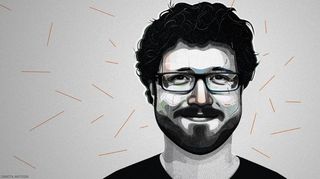Why web design is losing its soul
As responsive design becomes the norm, designers have developed a reliance on boxes and grids, argues Noah Stokes.

Don't be part of the web design herd! Mike Kus will be at Generate London in September where he'll urge you to be the black sheep: learn to extract organisations' identities and use them to craft truly distinctive web designs. Book now!
About a year and a half ago, I had seen enough. A tweet came through my stream and like so many others at the time, it was a link to a hot, new, amazing Responsive Web Design site.
"Oh, I love an amazing design," I thought, so I clicked. What I saw was a design casualty: boxes and grids everywhere. This was the 'amazing' new design? To me it looked like every other #RWD out there.
So I did what most people would do; I composed a tweet. "I hate #RWD."
That may not come off right, I thought. So I did a little re-composing. "I really hate #RWD."
Where's the magic gone?
That's more like it. It's blasphemy, right? RWD is the future of web development. The thing was, to me, the web was losing its magic. And I blamed RWD. In order for me to explain why, we have to go back to the web of the early 2000s.
In those days, websites called K10K, CSS Zen Garden, Stylegala and 2advanced were some of the biggest sources of website design inspiration out there. Stylegala would feature a Site of the Month that, for me, was like Christmas morning to a six year old.
I would spend hours exploring these sites, studying all the wonderful details; all the passion the designer had put into creating it.
Beauty in the intangible
Back to my tweet. I had enough wits about me to completely rewrite it to something less trolly and more politically correct. "I feel like responsive design has sucked the soul out of website design. Everything is boxes and grids. Where has all the creativity gone?"
Away it went. Someone created a branch around it that went on to get close to 15,000 views. A lot of folks (rightly so) were asking me to define what a 'soul' was.

This all goes back to my earlier references to K10K, Stylegala and so on. Those websites featured designs that were so unique, so full of thoughtfulness at every turn. My early exposure to web design was full of soul. So I would say: a soul is the intangible details of a design.
Stand-out sites
You've seen sites like this. Sites that stand out from the others. What sets those apart? To the untrained eye, they look like any other site, but to those of us that love design, these sites have a soul. I miss them. Why don't we see many of them around any more? I think I have a pretty good idea why.
Last year, Elliot Jay Stocks wrote an article called 'Why have today's designers stopped dreaming?' In it, he said:
"You click the website link and the assets begin to load. The page is a gigantic photo, filling the entirety of the viewport. In the photo is a group of people ... the product is just about visible on the screen of one of their iPhones. Overlaid on top of this photo is a brief sentence that introduces the product in a not-really-saying-anything-in-particular sort of way, set in a sans-serif typeface ...

"You're gently transitioned further down the page and the large, cheerful photo remains in place, without scrolling, until it's obscured by the main content area that appears from below ... You scroll a little further down the page and small diagrams begin to animate themselves as they enter the viewport.
"Then ... you notice that a semi-transparent menu has slunk into view and attached itself to the top of the page. It stays there as you scroll through the product descriptions, the giant bands of flat colours and the well-lit photos of the support team pulling their best 'fun' faces."
Sound like a website you've seen before? Trends come with the business, and they can be something to embrace. I love what Stocks goes on to say though – just because we have this style that is very minimal and subdued doesn't mean that we shouldn’t push ourselves as designers to create beautiful experiences online.
The RWD wrench

What about RWD? There's no doubt that RWD takes longer to develop than those old fixed-width sites of my past. Chris Cashdollar of Happy Cog wrote a great article about how RWD has kind of thrown a wrench.
With established patterns, it can become habitual to look at a design and break it apart in our minds, working out how we are going to do the markup for it. We do that based on our past experiences with similar designs – and sometimes when a design challenge comes along we get stuck because it doesn't fit inside the established patterns we know so well.
Push yourself to think outside that box. If you understand the fundamentals of the position property in CSS then you can literally do anything. If you don't yet fully understand it, or need a refresher, I wrote an article that may help.
RWD is the future, no doubt, and some of us are just now getting our feet beneath us. I'm excited to see what we build as we continue to learn and master responsive development. Even more so, I'm excited to see some of you bring some soul to your work, and bring some magic back to the web.
Learn from the experts at Generate London from 21-23 September! Two days of inspiring presentations from leading web experts, plus a day of practical, in-depth workshops; it's the perfect way to turbocharge your skills! Book now!
This article was originally published in net magazine. Subscribe today!

Thank you for reading 5 articles this month* Join now for unlimited access
Enjoy your first month for just £1 / $1 / €1
*Read 5 free articles per month without a subscription

Join now for unlimited access
Try first month for just £1 / $1 / €1
Get the Creative Bloq Newsletter
Daily design news, reviews, how-tos and more, as picked by the editors.
